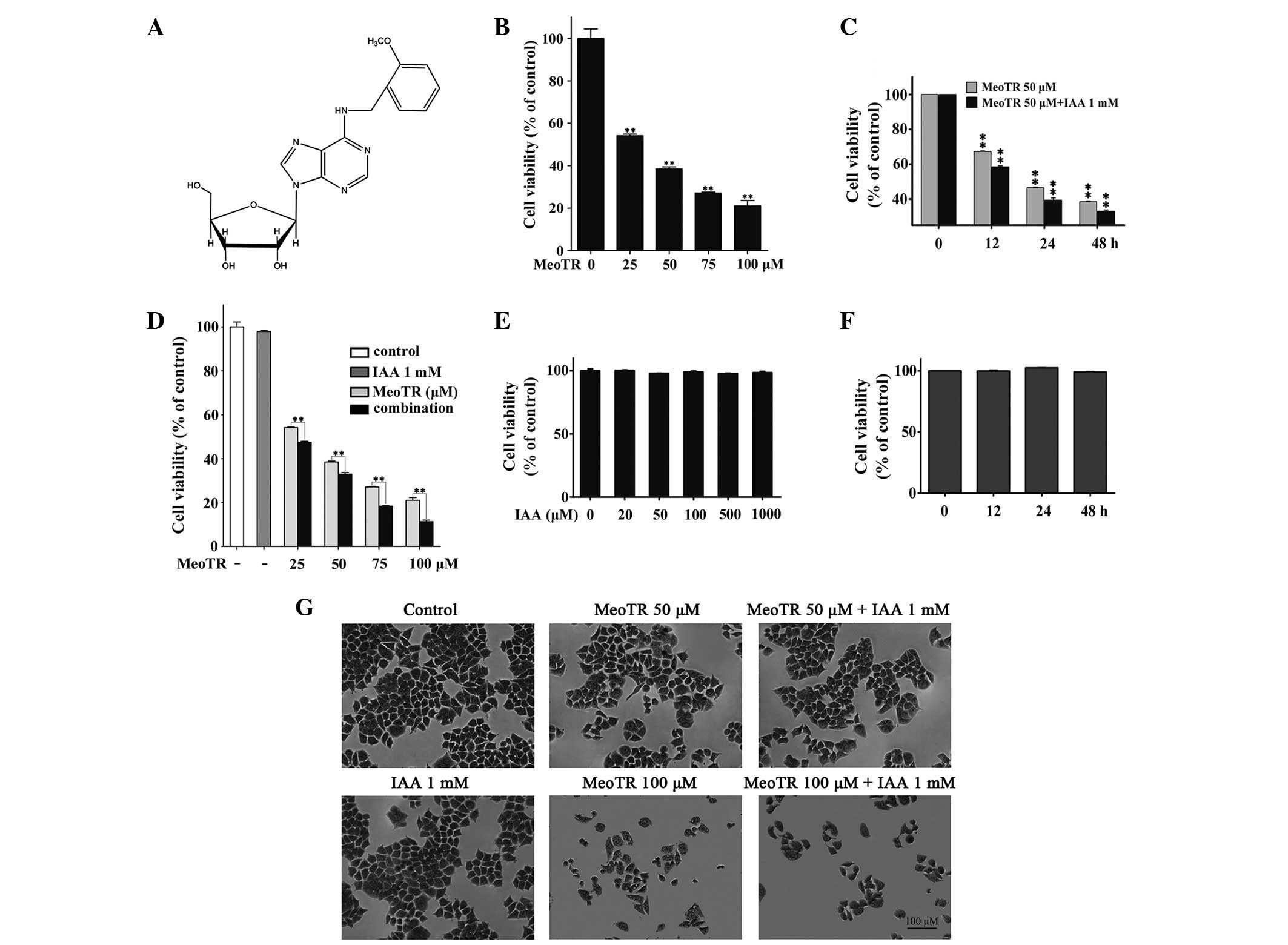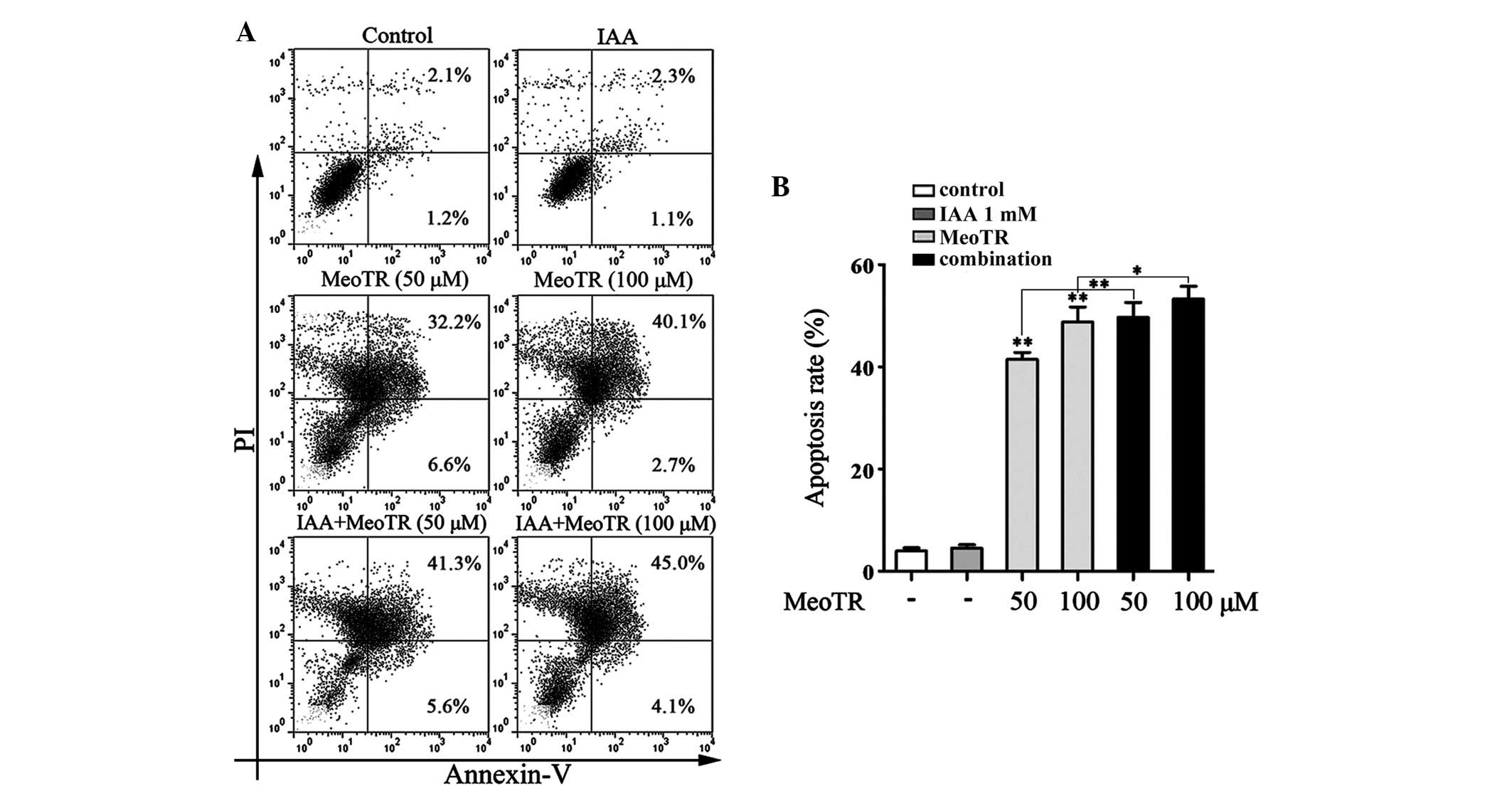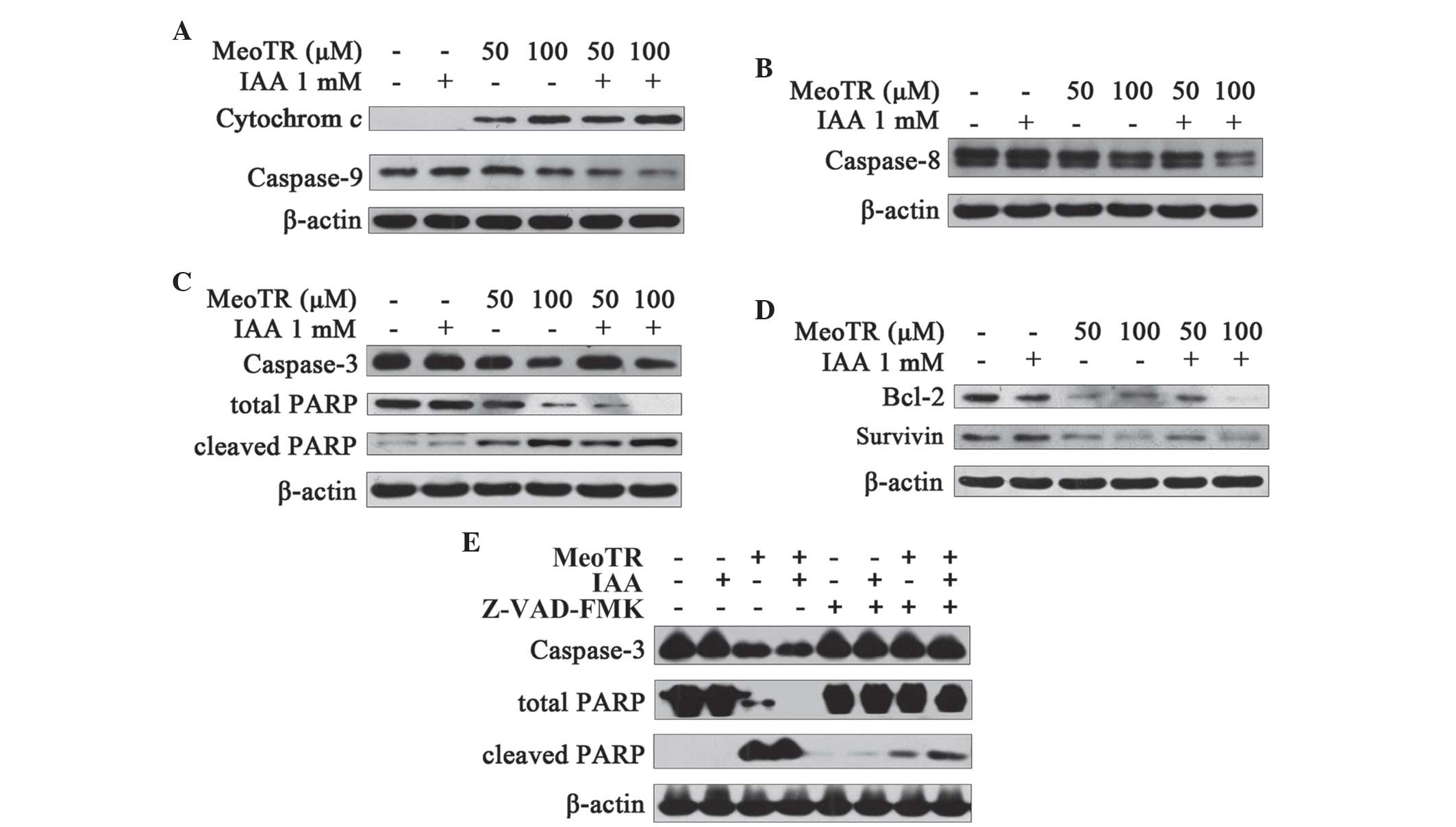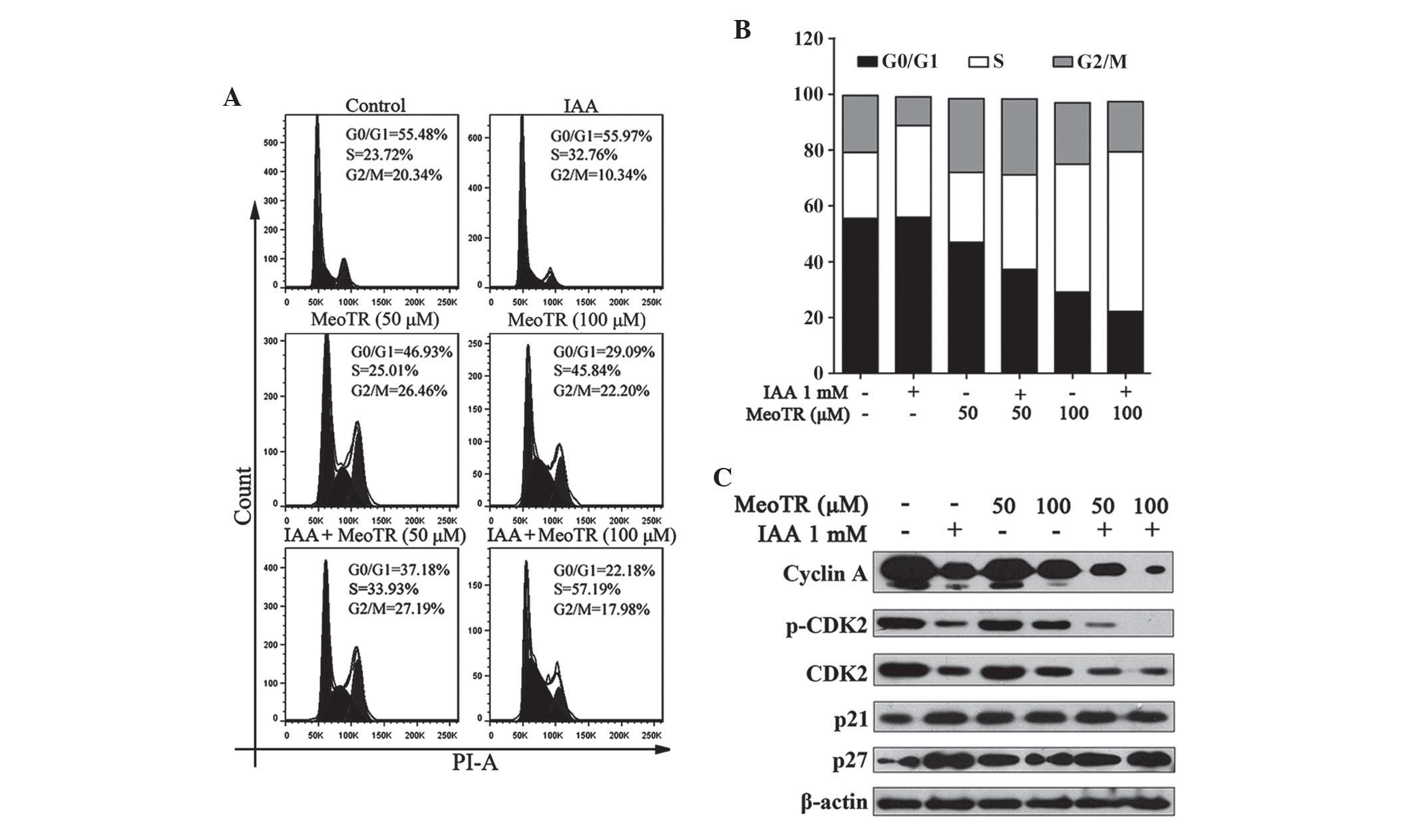|
1
|
Skoog F and Miller CO: Chemical regulation
of growth and organ formation in plant tissues cultured in vitro.
Symp Soc Exp Biol. 11:118–130. 1957.PubMed/NCBI
|
|
2
|
Dolezal K, Popa I, Hauserova E, et al:
Preparation, biological activity and endogenous occurrence of
N6-benzyladenosines. Bioorg Med Chem. 15:3737–3747. 2007.
View Article : Google Scholar : PubMed/NCBI
|
|
3
|
Strnad M: The aromatic cytokinins. Physiol
Plantarum. 101:674–688. 1997. View Article : Google Scholar
|
|
4
|
Barciszewski J, Massino F and Clark BF:
Kinetin-a multiactive molecule. Int J Biol Macromol. 40:182–192.
2007. View Article : Google Scholar
|
|
5
|
Horgan R, Hewett EW, Horgan JM, Purse J
and Wareing PF: A new cytokinin from Populus × robusta.
Phytochemistry. 14:1005–1008. 1975. View Article : Google Scholar
|
|
6
|
Jones LH, Martinkova H, Strnad M and Hanke
DE: Occurrence of aromatic cytokinins in oil palm (Elaeis
guineensis Jacq). J Plant Growth Regul. 15:39–49. 1996. View Article : Google Scholar
|
|
7
|
Ördög V, Stirk WA, Van Staden J, Novák O
and Strnad M: Endogenous cytokinins in three genera of microalgae
from the chlorophyta1. J Phycol. 40:88–95. 2004. View Article : Google Scholar
|
|
8
|
Cheong J, Goh D, Yong JW, Tan SN and Ong
ES: Inhibitory effect of kinetin riboside in human heptamoa, HepG2.
Mol Biosyst. 5:91–98. 2009. View
Article : Google Scholar
|
|
9
|
Ishii Y, Hori Y, Sakai S and Honma Y:
Control of differentiation and apoptosis of human myeloid leukemia
cells by cytokinins and cytokinin nucleosides, plant
redifferentiation-inducing hormones. Cell Growth Differ. 13:19–26.
2002.PubMed/NCBI
|
|
10
|
Ishii Y, Sakai S and Honma Y:
Cytokinin-induced differentiation of human myeloid leukemia HL-60
cells is associated with the formation of nucleotides, but not with
incorporation into DNA or RNA. Biochim Biophys Acta. 1643:11–24.
2003. View Article : Google Scholar : PubMed/NCBI
|
|
11
|
Wang L, Sun C, Wang ZH and Guo GQ:
Mechanism of apoptotosis induced by orthotopolin riboside in human
hepatoma cell line SMMC-7721. Food Chem Toxicol. 50:1962–1968.
2012. View Article : Google Scholar : PubMed/NCBI
|
|
12
|
Castiglioni S, Casati S, Ottria R,
Ciuffreda P and Maier JA: N6-isopentenyladenosine and its analogue
N6-benzyladenosine induce cell cycle arrest and apoptosis in
bladder carcinoma T24 cells. Anticancer Agents Med Chem.
13:672–678. 2013. View Article : Google Scholar
|
|
13
|
Goldsmith MH: Cellular signaling: new
insights into the action of the plant growth hormone auxin. Proc
Natl Acad Sci USA. 90:11442–11445. 1993. View Article : Google Scholar : PubMed/NCBI
|
|
14
|
Kim DS, Jeon SE and Park KC: Oxidation of
indole-3-acetic acid by horseradish peroxidase induces apoptosis in
G361 human melanoma cells. Cell Signal. 16:81–88. 2004. View Article : Google Scholar
|
|
15
|
Kim DS, Kim SY, Jeong YM, et al:
Indole-3-acetic acid/horseradish peroxidase-induced apoptosis
involves cell surface CD95 (Fas/APO-1) expression. Biol Pharm Bull.
29:1625–1629. 2006. View Article : Google Scholar : PubMed/NCBI
|
|
16
|
Folkes LK and Wardman P: Enhancing the
efficacy of photodynamic cancer therapy by radicals from plant
auxin (indole-3-acetic acid). Cancer Res. 63:776–779.
2003.PubMed/NCBI
|
|
17
|
Kim DS, Kim SY, Jeong YM, et al:
Light-activated indole-3-acetic acid induces apoptosis in g361
human melanoma cells. Biol Pharm Bull. 29:2404–2409. 2006.
View Article : Google Scholar : PubMed/NCBI
|
|
18
|
Kim SY, Ryu JS, Li H, et al: UVB-activated
indole-3-acetic acid induces apoptosis of pc-3 prostate cancer
cells. Anticancer Res. 30:4607–4612. 2010.PubMed/NCBI
|
|
19
|
Wang D, Wang Z, Tian B, Li X, Li S and
Tian Y: Two hour exposure to sodium butyrate sensitizes bladder
cancer to anticancer drugs. Int J Urol. 15:435–441. 2008.
View Article : Google Scholar : PubMed/NCBI
|
|
20
|
Vander Heiden MG, Chandel NS, Williamson
EK, Schumacker PT and Thompson CB: Bcl-xL regulates the membrane
potential and volume homeostasis of mitochondria. Cell. 91:627–637.
1997. View Article : Google Scholar : PubMed/NCBI
|
|
21
|
Alnemri ES, Livingston DJ, Nicholson DW,
et al: Human ICE/CED-3 protease nomenclature. Cell. 87:1711996.
View Article : Google Scholar : PubMed/NCBI
|
|
22
|
Hengartner MO: The biochemistry of
apoptosis. Nature. 407:770–776. 2000. View
Article : Google Scholar : PubMed/NCBI
|
|
23
|
Liu TZ, Cheng JT, Yiin SJ, et al:
Isoobtusilactone A induces both caspase-dependent and -independent
apoptosis in Hep G2 cells. Food Chem Toxicol. 46:321–327. 2008.
View Article : Google Scholar
|
|
24
|
Pap M and Cooper GM: Role of glycogen
synthase kinase-3 in the phosphatidylinositol 3-Kinase/Akt cell
survival pathway. J Biol Chem. 273:19929–19932. 1998. View Article : Google Scholar : PubMed/NCBI
|
|
25
|
Pap M and Cooper GM: Role of translation
initiation factor 2B in control of cell survival by the
phosphatidylinositol 3-kinase/Akt/glycogen synthase kinase 3beta
signaling pathway. Mol Cell Biol. 22:578–586. 2002. View Article : Google Scholar : PubMed/NCBI
|
|
26
|
Lin CF, Chen CL, Chiang CW, Jan MS, Huang
WC and Lin YS: GSK-3beta acts downstream of PP2A and the PI
3-kinase-Akt pathway and upstream of caspase-2 in ceramide-induced
mitochondrial apoptosis. J Cell Sci. 120:2935–2943. 2007.
View Article : Google Scholar : PubMed/NCBI
|
|
27
|
Bondar VM, Sweeney-Gotsch B, Andreeff M,
Mills GB and McConkey DJ: Inhibition of the phosphatidylinositol
3′-kinase-AKT pathway induces apoptosis in pancreatic carcinoma
cells in vitro and in vivo. Mol Cancer Ther. 1:989–997.
2002.PubMed/NCBI
|
|
28
|
Zheng WH and Quirion R: Insulin-like
growth factor-1 (IGF-1) induces the activation/phosphorylation of
Akt kinase and cAMP response element-binding protein (CREB) by
activating different signaling pathways in PC12 cells. BMC
Neurosci. 7:512006. View Article : Google Scholar : PubMed/NCBI
|
|
29
|
Chen T, Stephens PA, Middleton FK and
Curtin NJ: Targeting the S and G2 checkpoint to treat cancer. Drug
Discov Today. 17:194–202. 2012. View Article : Google Scholar
|
|
30
|
Vermeulen K, Van Bockstaele DR and
Berneman ZN: The cell cycle: a review of regulation, deregulation
and therapeutic targets in cancer. Cell Prolif. 36:131–149. 2003.
View Article : Google Scholar : PubMed/NCBI
|
|
31
|
Yoon MK, Mitrea DM, Ou L and Kriwacki RW:
Cell cycle regulation by the intrinsically disordered proteins p21
and p27. Biochem Soc Trans. 40:981–988. 2012. View Article : Google Scholar : PubMed/NCBI
|
|
32
|
Sarraf CE and Bowen ID: Proportions of
mitotic and apoptotic cells in a range of untreated experimental
tumours. Cell and tissue kinetics. 21:45–49. 1988.PubMed/NCBI
|
|
33
|
Wyllie AH: Apoptosis (the 1992 Frank Rose
Memorial Lecture). Br J Cancer. 67:205–208. 1993. View Article : Google Scholar : PubMed/NCBI
|
|
34
|
Green DR: Apoptotic pathways: paper wraps
stone blunts scissors. Cell. 102:1–4. 2000. View Article : Google Scholar : PubMed/NCBI
|
|
35
|
Scoltock AB and Cidlowski JA: Activation
of intrinsic and extrinsic pathways in apoptotic signaling during
UV-C-induced death of Jurkat cells: the role of caspase inhibition.
Exp Cell Res. 297:212–223. 2004. View Article : Google Scholar : PubMed/NCBI
|
|
36
|
Li P, Nijhawan D, Budihardjo I, et al:
Cytochrome c and dATP-dependent formation of Apaf-1/caspase-9
complex initiates an apoptotic protease cascade. Cell. 91:479–489.
1997. View Article : Google Scholar : PubMed/NCBI
|
|
37
|
Boatright KM, Renatus M, Scott FL, et al:
A unified model for apical caspase activation. Mol Cell.
11:529–541. 2003. View Article : Google Scholar : PubMed/NCBI
|
|
38
|
Kruyt FA and Schuringa JJ: Apoptosis and
cancer stem cells: Implications for apoptosis targeted therapy.
Biochem Pharmacol. 80:423–430. 2010. View Article : Google Scholar : PubMed/NCBI
|
|
39
|
Budihardjo I, Oliver H, Lutter M, Luo X
and Wang X: Biochemical pathways of caspase activation during
apoptosis. Annu Rev Cell Dev Biol. 15:269–290. 1999. View Article : Google Scholar : PubMed/NCBI
|
|
40
|
Hockenbery DM, Oltvai ZN, Yin XM, Milliman
CL and Korsmeyer SJ: Bcl-2 functions in an antioxidant pathway to
prevent apoptosis. Cell. 75:241–251. 1993. View Article : Google Scholar : PubMed/NCBI
|
|
41
|
Kim E, Matsuse M, Saenko V, et al:
Imatinib enhances docetaxel-induced apoptosis through inhibition of
nuclear factor-kappaB activation in anaplastic thyroid carcinoma
cells. Thyroid. 22:717–724. 2012. View Article : Google Scholar : PubMed/NCBI
|
|
42
|
Lee R and Collins T: Nuclear factor-kappaB
and cell survival: IAPs call for support. Circ Res. 88:262–264.
2001. View Article : Google Scholar : PubMed/NCBI
|
|
43
|
Brazil DP and Hemmings BA: Ten years of
protein kinase B signalling: a hard Akt to follow. Trends Biochem
Sci. 26:657–664. 2001. View Article : Google Scholar : PubMed/NCBI
|
|
44
|
Lawlor MA and Alessi DR: PKB/Akt: a key
mediator of cell proliferation, survival and insulin responses? J
Cell Sci. 114:2903–2910. 2001.PubMed/NCBI
|
|
45
|
Martelli AM, Tazzari PL, Tabellini G, et
al: A new selective AKT pharmacological inhibitor reduces
resistance to chemotherapeutic drugs, TRAIL, all-trans-retinoic
acid and ionizing radiation of human leukemia cells. Leukemia.
17:1794–1805. 2003. View Article : Google Scholar : PubMed/NCBI
|
|
46
|
Kim SY, Ryu JS, Li H, et al: UVB-activated
indole-3-acetic acid induces apoptosis of PC-3 prostate cancer
cells. Anticancer Res. 30:4607–4612. 2010.PubMed/NCBI
|
|
47
|
Folkes LK and Wardman P: Oxidative
activation of indole-3-acetic acids to cytotoxic species-a
potential new role for plant auxins in cancer therapy. Biochem
Pharmacol. 61:129–136. 2001. View Article : Google Scholar : PubMed/NCBI
|















